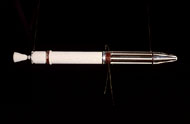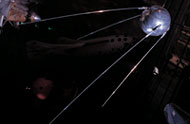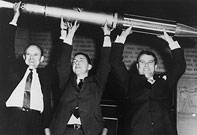| |
||||||||||||
|
Explorer 1 became America's first satellite on January 31, 1958. Following the Soviet success with Sputnik and the embarrassing failure in December 1957 of the first American attempt to launch a satellite, the U.S. Army launched a scientific satellite using a rocket that had been developed to test guided missile components. Explorer 1 carried an instrument package developed by a team at the State University of Iowa under the direction of Professor James A. Van Allen. Data returned by Explorer 1 and Explorer 3 (launched in March 1958) provided evidence that the Earth is surrounded by intense bands of radiation, now called the Van Allen radiation belts. This was the first major scientific discovery of the space age. Design Features (in comparison to Sputnik 1):
Explorer 1 This satellite was built as a backup-an identical
unit for the original Explorer 1. It could have been launched if
the first one had failed. The striped portion contains the instruments,
radios, and batteries. It is attached to a single solid-propellant
rocket motor, which served as the launch vehicle's fourth stage.
Transferred from the Jet Propulsion Laboratory and NASA More Information:
|
![]() 1957
Sputnik 1 | Milestones of Flight | 1959
North American X-15
1957
Sputnik 1 | Milestones of Flight | 1959
North American X-15 ![]()
© National Air and Space Museum


